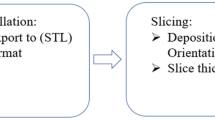Abstract
This research investigates the integrated design, robotic fabrication and materialisation of novel air-diffusion systems for contemporary office environments. Specifically, the research focuses on the integration of computational design, multi-objective optimisation and the development of novel approaches and techniques for large-scale 3D-printed module systems for low-embodied energy air ducts in the context of a pilot study for an open office environment. By investigating the interrelationship of polymer extrusion, material behaviour, computational design, computational fluid dynamic (CFD) simulation and multi-objective optimisation, the research leverages the capacities of each of these methods to create highly detailed geometries that are optimised for air diffusion to create locally differentiated thermal comfort. The paper contributes to and further extends existing research in the domain of large-scale 3D printing by presenting a series of developed novel approaches and techniques combining the diverse methods above to address the plural performance demands of low-embodied energy air-diffusion systems. It presents empirical research towards air simulation, geometry optimisation and bespoke fabrication for a high-quality, customised and resilient air-diffusion system to support the flexibility of contemporary office environments and reduce the adverse per capita environmental impact of cities through increased resource-use efficiency and substantial waste and embodied energy reduction.
















Similar content being viewed by others
References
ASHRAE (2005) Handbook: Fundamentals -, SI. American Society of Heating Refrigerating and Air-Conditionin, Atlanta, Ga.
Bhate Dhruv (2015) 3D Printed Plastics in Functional Aerospace Parts. (Accessed 17 July 2020)
3D Fuel 2020. https://www.3dfuel.com/products/rpetg Accessed 12 May 2020
Hack N, Lauer WV (2014) Mesh-Mould: Robotically Fabricated Spatial Meshes as Reinforced Concrete Formwork. Architect Des 84(3):44–53. https://doi.org/10.1002/ad.1753
Kim T, Lee Y-G (2018) Shape transformable bifurcated stents. Scientif Rep 8(1):13911–13911. https://doi.org/10.1038/s41598-018-32129-3
Kuzmenko K, Gaudilliere N, Feraille A, Dirrenberger J, Baverel O (2019) Assessing the environmental viability of 3D concrete printing technology. Design modelling symposium - impact: design with all senses. Springer, Cham
Lyons BP (2014) Additive manufacturing in aerospace: examples and research outlook. Front Eng 42(1):13–19
Laarman J, Jokic S, Novikov P, Fraguada L, Markopoulou A (2017) Anti-Gravity Additive Manufacturing. In: Gramazio F, Kohler M, Langenberg S (eds) Fabricate 2014: Negotiating Design & Making. UCL Press, London, pp 192–197
Nagami. https://www.nagami.design/en/. Accessed 6 April 2020
Noller C (2020) The Green Book. The Footprint Company, Sydney
Pataky K, Braschler T, Negro A, Renaud P, Lutolf M, Brugger J (2012) Microdrop printing of hydrogel bioinks into 3D tissue-like geometries. Adv Mater (Deerfield Beach, Fla). https://doi.org/10.1002/adma.201102800
Soler V, Retsin G, Jimenez Garcia M (2017) A Generalized Approach to Non-Layered Fused Filament Fabrication. Paper presented at the Disciplines & Disruption: Proceedings of the 37th Annual Conference of the Association for Computer Aided Design in Architecture (ACADIA) Cambridge, MA
Singamneni S, Lv Y, Hewitt A, Chalk R, Thomas W, Jordison D (2019) Additive manufacturing for the aircraft industry: a review. J Aeronaut Aerospace Eng 8(214):2. https://doi.org/10.4172/2329-6542.1000214
Volker H, Willmann J, Thoma A, Piskorec L, Hack N, Gramazio F, Kohler M (2015) Iridescence print: robotically printed lightweight mesh structures. Printing Add Manuf 2:117–122. https://doi.org/10.1089/3dp.2015.0018
Acknowledgments
The authors thank Tran Dang, Gwyn Jones and Lucy Wang from UTS as well as Mitch Page and Phil Spedding from BVN for their valuable contributions and technical support. Our industry contributors Enrico Zara, Mairead Hogan, Steve Drane, Camilo Chalela, Chris Macdonald and Nawreen Sultana from Arup, Dr. Caroline Noller from The Footprint Company, Barry Dineen and Dominic Hawton from BVN Real. We would further like to acknowledge Kavanagh Industries, Patrick Ibrahim (Equilibrium Air Conditioning), Michael Morley (CBRE), Ben Doherty, Aidan Ray, Ishaan Varshney and Urban Art Projects for their valuable insights.
Author information
Authors and Affiliations
Corresponding author
Additional information
Publisher's Note
Springer Nature remains neutral with regard to jurisdictional claims in published maps and institutional affiliations.
Rights and permissions
About this article
Cite this article
Schork, T., Titchkosky, N., Bickerton, C. et al. The geometry of air: large-scale multi-colour robotic additive fabrication for air-diffusion systems. Constr Robot 5, 49–61 (2021). https://doi.org/10.1007/s41693-021-00054-z
Received:
Accepted:
Published:
Issue Date:
DOI: https://doi.org/10.1007/s41693-021-00054-z




